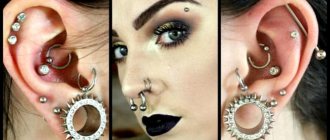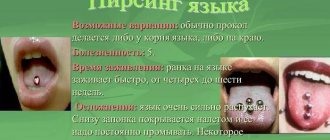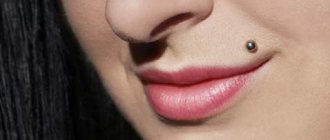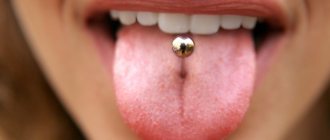Nowadays, more and more people are striving to break out of the gray mass, in any way to stand out from the crowd, so many teenagers (and adults too) resort to changes in appearance. They may not always be colossal, but nevertheless people change themselves day after day. One such way of self-expression is piercing. Piercing can also serve as a sign that you belong to a particular subculture, such as punks or rockers. Nowadays, various subcultures are becoming increasingly popular among young people.
The meaning of piercing
Piercing is a form of modification of any part of the body with soft skin tissue in order to insert jewelry there. Thus, the individual wants to emphasize her beauty and receive aesthetic pleasure. They use such decorations as labrets, rods, tunnels, studs and rings, but that’s not all! The most common facial piercings are eyebrow, lip, nose and tongue piercings. Piercings are also done on the navel and private parts of the body. The very concept of “piercing” can imply both the piercing process and the hole itself. Below are photos of tongue piercings and other types of punctures.
Variety of earring options for men
For vertical piercing, as well as for ear-to-ear piercings, only a barbell is used.
For superficial piercings, use a regular barbell or a barbell bent to accommodate a plane puncture. Segment rings or with ball-shaped clasps can also be used. They are also used for the tip. But spirals with circular shapes can also suit him.
For the frenulum of the tongue, horseshoes or a banana are used.
The history of piercing
In ancient times, people from different tribes showed their class affiliation by piercing their ears, nose and other parts of the body, and it was believed that the more jewelry a person had on his body, the more authoritative the member of the tribe. Among the ancient Indians, a large number of punctures on the face was considered a symbol of courage, and ancient Roman warriors preferred to pierce their nipples - this meant courage and masculinity.
As for tongue piercing specifically, the story with it is much more interesting. The ancient Aztecs in the Mayan tribes of Central America pierced their tongues in order to release blood and appease the gods, thus making a kind of sacrifice. After the tongue was pierced, the blood was burned. It was believed that this ritual connected a person with God. A similar custom also existed among the Australian Aborigines, but they did it to release evil magic.
Which metal jewelry should you prefer?
For the first time after surgery, it is recommended to wear simple jewelry that is not framed with stones or patterns. Select the following material:
- Hypoallergenic plastic.
- Can be replaced with Teflon.
- If gold, then only high standard - 585 or 700.
- You can use surgical implant metal, but then replace it with a more expensive material.
When the hole is completely healed, you can afford another decoration. For lips, try to give preference to hypoallergenic materials. They have high biocompatibility with human skin and tissues. Moreover, they do not irritate the mucous membrane. In addition to standard metals, these can be amber, wood, niobium and even ivory.
Despite the widespread use of surgical metal products, you should not wear them immediately after a piercing. Due to the high concentration of nickel, such earrings often cause complications and suppuration of wounds.
General Information About Tongue Piercings
Before you pierce your tongue, you must determine for yourself whether you need it and prepare yourself mentally. Weigh the pros and cons of tongue piercing below. Of course, you can remove it at any time, and specifically piercing your tongue will certainly not disfigure you in any way, but the point is careful care, and you should also consult a doctor and find out if you have any contraindications, for example, sugar diabetes or allergies to certain types of metals. The wound, that is, the hole in the tongue, heals much faster than other types of piercing, but it requires more attention, since if it becomes infected, you can face serious threats to your health. Its essence lies in the fact that the soft fibers of the tongue are pierced, followed by the insertion of a special decoration - a barbell.
Contraindications and possible consequences - can everyone have their tongue pierced?
Despite its wide popularity, piercing of this part of the body is not accessible to everyone. There is a whole list of contraindications that prohibit intentional injury to an organ:
- inability to take the healing period seriously: you should not get a piercing if you currently do not have the time and suitable conditions to regularly treat the wound, rinse and wash,
- pregnancy period: during this period, the risk of critical infection poses a truly serious threat, so it is simply unreasonable to expose yourself and the child to danger once again,
- allergy to antibiotics: in this case, the potential complication of infection can be fatal,
- allergy to metals,
- poor blood clotting,
- mental illness,
- epilepsy,
- oral diseases,
- autoimmune diseases, hemophilia, diabetes mellitus - all these are strict contraindications to intentional damage to the oral mucosa. If you have any health problems, it would be a good idea to consult your doctor.
Important! In Russia, piercing is allowed for persons who have reached the age of majority - 18 years. In some cases, it is possible to carry out the procedure from the age of 16, but only with the written official consent of the parents1.
Tongue diseases can cause poor wound healing
In addition to many contraindications, tongue piercing has a number of serious complications. Of course, today in medical centers and decent salons all risks are reduced to a minimum, but the likelihood of encountering a serious problem still remains. So, an infection can penetrate into the wound or the metal can provoke an allergic reaction. If the technician performs inept actions, bleeding may occur or a nerve may be damaged, which will lead to partial loss of sensitivity. The most dangerous possible consequence is infection through instruments - hepatitis, HIV and other dangerous diseases.
Pros of piercing
- Through piercing a person liberates himself and tries something new in life.
- A girl's tongue piercing looks very sexy and also gives new sensations during kissing.
- During healing, you will need to adhere to a strict diet, with which you can even lose a couple of extra pounds.
- Low pain due to the needle passing between the muscle fibers.
- There is very little chance of getting an infection due to the antimicrobial properties of saliva.
You can find and identify for yourself several more advantages of tongue piercing, which consist, for example, in the beauty of this procedure.
Now let's move on to the disadvantages, which are also important and even necessary to familiarize yourself with before getting a piercing.
Reasons for pain
The following factors can cause characteristic tongue pain:
- Organ injuries.
- Inflammation.
- Allergy.
- Neurological disease.
- Pathologies of internal organs.
- Tumor formation.
- Blockage of the salivary gland.
The most common cause of pain on one side of the tongue is damage to it. As a rule, this is noted during meals. Injuries may include burns, pinching, or scratches. As a result, pain can occur on the upper part, under the tongue or in its side.
Also, a muscular organ can hurt due to a chipped layer of tooth enamel, tingling from the sharp edge of a filling, or prosthetics performed with violations. With mechanical influence, increased pain is noted. In a situation where a patient has difficulty swallowing, and there is also discomfort in the throat or palate, there is a need to visit a doctor and ask him why this is happening.
You should pay attention to the nasopharynx, since as a result of its damage, one sign may appear - swelling of the lymph nodes under the tongue. Many parents are puzzled by the question of why a child’s tongue may hurt at its base, as well as its side, accompanied by plaque and pain when swallowing
But only a qualified doctor can help resolve this issue due to the possible presence of purulent sore throat, which requires immediate administration of adequate therapy
Many parents are puzzled by the question of why a child’s tongue may hurt at its base, as well as its side, accompanied by plaque and pain when swallowing. But only a qualified doctor can help resolve this issue due to the possible presence of purulent sore throat, which requires immediate administration of adequate therapy.
An allergic reaction often occurs due to the fault of certain products, as well as medications. Moreover, signs may appear immediately after their adoption. Some fruits, berries, smoking and alcohol can serve as provocateurs. Neurological disease glossalgia, which arises under the influence of a malfunction of the endocrine system and neurotic disorders. So, a sick person may experience burning, tingling and numbness of the organ.
Diseases of internal organs of unknown etiology often cause pain. All this happens due to various changes in human health, since the tongue reacts sharply to any ailments of an infectious nature - glossitis, as well as pathologies of the gastrointestinal tract, cardiovascular system and even anemia.
Oncological lesions often create conditions for the tongue to begin to hurt on the right or left side. Because of this, the pain syndrome is localized inside the tongue. Moreover, the nature and intensity of pain directly depends on the stage of the malignant disease. In this case, the patient is referred to an oncologist.
Cons of piercing
- Swelling and discomfort during healing.
- A metal barbell or other decoration can damage your mouth or teeth.
- Getting an infection can lead to a number of dangerous complications.
- There may be a violation of taste analyzers and/or diction.
- If you want the procedure to be performed efficiently, you will have to pay quite a lot for it. It is better to choose a more qualified surgeon than to have it done in an unknown place or with someone unknown.
The above contains equal parts of both pros and cons, so that you do not depend on this article and think for yourself, adding a few more points of your own. It is absolutely necessary to read tongue piercing reviews before the procedure.
If you have already had your tongue pierced, then the surgeon who pierced your tongue most likely told you how to properly care for it so as not to infect the wound. But for those who don’t know or for those who have pierced their tongue at home, below are instructions for caring for a tongue piercing.
How to make a puncture
To know what to expect, you first need to find out exactly how the piercing procedure is performed. So, this process involves the following steps:
- to begin with, the tongue is placed in a special tool - a clamp, in the center of which there is a hole for decoration,
- after this, the master makes a puncture, for which he uses a special sterile needle intended for one-time use,
- a “barbell” is inserted through a special hole in the needle, after which the needle and clamp are removed,
- after this, the oral cavity is treated with a disinfectant solution, for example, Chlorhexidine.
The photo shows the procedure for piercing the tongue.
If the procedure was carried out during the day, then in the evening the tongue will inevitably swell and cause some inconvenience. The speed of healing largely depends on the individual characteristics of the human body. For some, this process takes five days, for others – two weeks. Keep in mind that during this period you will have to exclude spicy foods and acid-containing foods from your diet, and, if possible, limit the consumption of solid foods. It is also recommended to talk less and move your tongue so as not to accidentally touch the wound.
Proper care
Care involves mandatory treatment of the oral cavity with an antiseptic, for example, a solution of potassium permanganate or soda. During the first few weeks, approximately the first two weeks, rinse your mouth with this solution after every meal and generally as often as possible. If you think that the tongue has begun to more or less heal, you should change the antiseptic to a softer one so as not to destroy the beneficial properties of saliva and not to injure the oral cavity. A milder remedy could be, for example, a decoction of some herbs, at best chamomile. At first, avoid spicy and hot foods; they can promote inflammation and the formation of ulcers and bleeding from the wound.
The bar, of course, also requires careful care. At first, brush it with a soft toothbrush, and later you will have to remove it regularly and disinfect it. This will need to be done even with complete healing.
Caring for the puncture site: dos and don’ts after the procedure
How to care for a pierced tongue immediately after the piercing procedure during the initial healing stage:
- Accept that in the first days the wound may bleed and be bothered by excessive sensitivity. This is normal for the first period.
- To relieve swelling, drink ice water. You can keep the ice in your mouth for a while. It will become easier. To avoid frostbite in the mouth, use small pieces.
- Don't smoke, don't drink alcohol, don't drink a lot of coffee, avoid French kissing, oral sex. Avoid chewing gum. Don't play with the decoration yet.
- Eliminate spicy, salty, sour, and hot foods for a while.
- Whitish mucus may be discharged. If it's not pus, there's no need to worry.
Further care is as follows:
- Before each cleaning, wash your hands thoroughly with soap, preferably antibacterial. Apart from cleaning, do not touch the wound yet.
- In the first days, you need to rinse your mouth with an alcohol-based, fluoride-based rinse (4-5 times after meals and before bed). The duration of the procedure is 1 minute.
- Clean the wound with sea salt twice daily. Then wash it with antimicrobial soap. But don't do this procedure often.
- You need to dry the puncture correctly. Do not wipe it with a bath towel. To do this, use a disposable napkin or paper towel.
Tongue piercing process
If you turn to a competent specialist, he will do everything efficiently, painlessly and in the best possible way. Then everything will depend on you. But the process of piercing the tongue itself will be described below. If you are hesitant and don’t know whether to get your tongue pierced, or are afraid of pain, then read the step-by-step description of the piercing, and perhaps you will calm down.
So, the sequence of actions:
- The surgeon pre-processes all the instruments that will be needed.
- The master puts on gloves, which he also disinfects.
- The oral cavity should be thoroughly rinsed with an antiseptic solution, and the tongue should be separately disinfected with an antiseptic gel.
- The master makes the necessary marks with a marker.
- A puncture is made with a sterile clean needle and the earring is inserted.
- The oral cavity is again disinfected with an antiseptic solution.
Frenulum
This is what is called a frenulum piercing. It is quite painful and can harm your teeth, so you should choose jewelry carefully. Not everyone can do such a piercing - it depends on the anatomical features. In addition, sometimes there is rejection.
Tongue piercing at home
If you decide to do a tongue piercing yourself, at home, which is extremely undesirable, then it is done as follows.
- Buy a disposable catheter and antiseptic at the pharmacy.
- Rinse your mouth with a disinfectant solution.
- Also treat the earring with alcohol.
- Lift your tongue with your fingers and make a mark between the two arteries. The mark should be exactly in the middle, this is very important!
- It's quite difficult to inflict pain on yourself, but next you will need to hold your tongue firmly and pierce it from the bottom up with a needle.
- While the needle is in the tongue, insert the jewelry without removing it.
- Rinse your mouth thoroughly with disinfectant.
Those people who have already tried to do this on their own will tell you that it is better to go to specialists. Despite the fact that the procedure seems extremely simple, it is not worth doing at home. Even an experienced doctor can sometimes damage your nerve or hit vital arteries, and it’s scary to think what you can do to yourself. Therefore, the opinion of surgeons regarding independent manipulation is sharply negative.
Touching on this topic, it is worth talking about the possible consequences of tongue piercing.
Choosing jewelry for girls (women), men
Before the procedure, the piercer will help you choose jewelry if the client has not purchased it in advance. If you want to buy it yourself, then a few tips below will help you make the right choice.
It is worth noting that there is no clear division between women's and men's jewelry. But unwritten rules still exist:
Consequences
If you went to an experienced doctor, then with proper treatment and care there will, of course, be no serious consequences. But an unsuccessful piercing may be accompanied by heavy bleeding if an artery is damaged or an unnatural color of the tongue. Improper puncture is harmful to your health, so in such a situation you should consult a surgeon.
Possible consequences of tongue piercing:
- Purulent discharge.
- Discomfort, burning sensation and almost unbearable pain.
- Unpleasant smell.
- A piece of jewelry that doesn't suit you can grow into your tongue, which will interfere with normal conversation.
- Paralysis of some muscles of the oral cavity, including the tongue.
- Violation of tooth enamel and gums, teeth become more brittle and weaker.
Quite unpleasant consequences, right? Be careful about yourself and your choice of piercer to prevent this from happening.
When should you see a doctor?
You should consult a doctor if signs of infection develop
Qualified medical care should be sought if:
- there are signs of infection, such as fever, severe pain, new swelling, or enlarged lymph nodes in the neck;
- symptoms of infection do not subside several days after starting treatment;
- the site of tissue damage constantly bleeds;
- green or yellow pus is released from the site of injury;
- there is an unpleasant odor from the mouth;
- toothache or swollen gums;
- swelling develops or tissue growths form anywhere in the oral cavity.
In addition to meeting with your doctor, you can also visit a piercer and get recommendations on how to relieve pain and other symptoms.
Many piercers give their clients tips to speed up healing and ease discomfort.
However, it is important to understand that consultations with a piercer cannot replace the advice of a doctor.
Manufacturing materials and decoration
It is important that your very first barbell is of high quality. When selecting it, the specialist must take into account the features of your anatomy. The ideal barbell is one that has no rough edges, is long enough (the tongue can swell), and is straight. Also, it should not be too thin so that it does not have the opportunity to migrate and cause discomfort.
Ideal materials are platinum, niobium, Teflon and gold. Silver would be fine too. The same goes for horseshoes, rings, circulars, etc. Decorations for Lingum and Scoop can be quite subtle.











